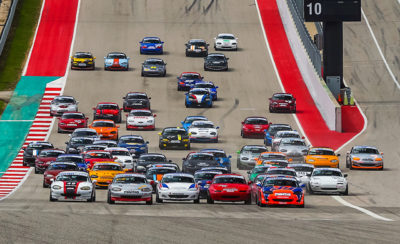Traffic – faster or slower – is a fact of life in racing, and successful racers are those who deal with it best
Everyday drivers deal with traffic on a near constant basis, often with a large dose of frustration. But while commuters can indulge themselves listening to a favorite podcast or music through their Bose Centerpoint 2 sound system in the Mazda CX-9, racing drivers have no such luxury. For them, traffic is maybe the point during a race when their focus and concentration are at their highest.
Dealing with traffic – both passing slower cars while in a battle, or having faster cars lap you and temporarily interrupt your race – is a fact of life at all levels of sports car racing. Even Spec Miata racers who are in a big field of theoretically equal cars are going to come across backmarkers – rookies getting up to speed or a driver experiencing mechanical problems. In those cases, threading through quickly without giving anything to your competitors is critical.
“It can make or break you,” says John Dean II, a two-time Idemitsu Mazda MX-5 Cup presented by BFGoodrich champion. “There are times when you’re leading and you’ve got a guy close behind you. You see that car coming up ahead and you’re wondering, ‘How’s my timing going to work? How am I going to catch that guy?’ And you’re trying to figure out the timing and adjust it a little bit. But you can’t adjust it too much, because the guy behind you will pass you. You’re trying to time it so when you pass, it’s going to be most advantageous for you and least advantageous for the guy trying to race you.”
In other words, you may not want to keep barreling toward the lapper’s back bumper at full tilt. If you catch the racer in the wrong spot, not only could it be tough to pass right there, but you may also lose momentum in the process. That’s something Harry Tincknell, driver of the No. 55 Mazda RT24-P for Mazda Team Joest in the IMSA WeatherTech SportsCar Championship, understands all too well. With the RT24-Ps being in the fastest Daytona Prototype international class, Tincknell is passing a lot of slower GTLM and GTD cars during a couple-hour on-track stint.
“It’s getting through as quick as possible with the least amount of risk,” Tincknell explains. “I try to be quite aggressive in practice sessions, so I really work out the places you can overtake and the places you need to stay behind. It helps that I’ve driven GT cars for years, so I know what they’re going through and what they’re experiencing. That experience is really key when you’re in a prototype and you’re the fast car coming through traffic.
“The key is to work out how much you gain on the car in each particular corner, and try to work out, as you’re coming up to them, if you can out brake them or pass them into the corner, or if you need to stay behind and pass on the exit.”
That’s an area where most club racers can use their experience as both passer and the one being passed; unless you’re racing a Formula Atlantic or P1 car, or perhaps a GTL or EP Miata in a small-bore field, you’re going to get passed by faster cars during the course of a practice session or race. Add the information you gather in that situation to your knowledge base for when you are the passer. Did the faster car catch you mid-corner, lose all of its momentum and still didn’t get by you on the following straight? Now you know not to do that.
“It’s no good driving up to the back of them halfway through the corner and having no momentum on the exit. That’s how you get overtaken when you’re in a battle with another person. You need to lift off and coast up to them so that you get on the power early and still get the same exit you would have if they weren’t there,” explains Tincknell, adding that there are three main options: Are you close enough to pass them under braking for the corner; if you need to stay behind, can you stay flat because you won’t catch them before corner exit; and do you need to lift so you can get a clean exit off the corner?
“Sometimes you have to take a few 50-50s to get through because there are cars trying to get by you,” he continues. “But it’s all about getting through as quickly as possible without hitting anything.”
In a future installment on racing through traffic, MazdaMotorsports.com will discuss using traffic as a pick to make a pass on a competitor, and the very frustrating situation of having a car with similar lap times but very different characteristics racing near you.


 ACCESSIBILITY
ACCESSIBILITY